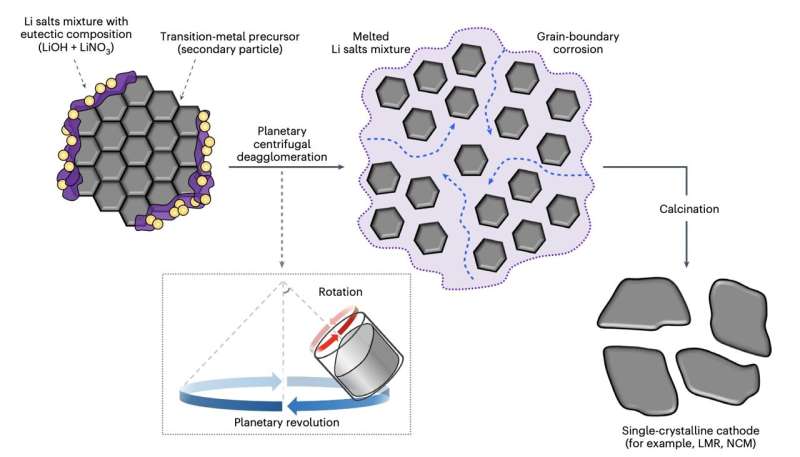
Energy engineers and material scientists are continuously trying to create safe battery technologies that exhibit higher energy densities and efficiencies, along with longer life cycles. As lithium-ion batteries (LiBs) are among the most widespread battery technologies, many current research efforts focus on improving the individual components of these batteries, including cathodes, the positive electrodes inside battery cells.
Most proposed cathodes for LiBs have polycrystalline morphologies, meaning that they are comprised multiple different crystalline particles. While these cathodes are easy to fabricate on a large-scale, they are prone to cracking during battery cycling, which can isolate some active materials inside them, exposing them to liquid electrolytes and potentially degrading the battery's performance.
Single-crystal cathodes, which are based on single grain-sized crystalline particles, could potentially help to overcome this crucial limitation of polycrystalline cathodes. However, reliably fabricating them using scalable processes has so far proved challenging.
Researchers at Massachusetts Institute of Technology (MIT) and the Ulsan National Institute of Science and Technology (UNIST) in South Korea recently introduced a new scalable strategy for synthesizing single-crystalline cathodes with a high phase purity and good electrochemical performance. This strategy, introduced in Nature Energy, consists in using molten Li salts to corrode the boundaries between smaller grains and transform them into bigger crystals, resulting in single-crystal layered cathodes.
"Constrained by the accessible temperature range to prevent lithium evaporation, lattice defects and particle agglomerations, the production of single-crystalline cathodes with high phase purity, good electrochemical performance and scalability remains challenging," Moonsu Yoon, Yanhao Dong and their colleagues told Tech Xplore.
"We invent a new mechanochemical activation process that offers a general solution to the conundrum of synthesizing coarse single-crystal cathodes with Li-/Mn-rich or Ni-rich chemistry, which differs from the equipment- and energy-intense and long-duration mechanochemical routes that are difficult to scale up."
The strategy for synthesizing single-crystal cathodes proposed by Yoon, Dong and their colleagues is based on a planetary centrifugal deagglomeration technique. The team showed that this strategy could enable the scalable production of single-crystal cathodes from materials that are easy to source, as they are commercially available.
"Our approach is based on interfacial reactive wetting, mediated by transient eutectic salts in situ melted by moderate mechanical agitations, to form a colloidal suspension of nanosized oxides dispersed in liquified lithium salts," Yoon, Dong and their colleagues wrote in their paper. "It efficiently deagglomerates the polycrystalline precursors, repacks the crystals and homogenizes the lithium-salt distribution, thus enabling facile particle coarsening later into the single-crystalline morphology with improved electrochemical performance."
Notably, the molten Li salts used by the researchers can produce the desired reaction without the need for additional chemicals. Their synthesis strategy can also be easily integrated with existing cathode manufacturing processes, which could greatly facilitate its widespread adoption.
This recent study could soon inform the development of additional strategies for creating highly performing single-crystal cathodes for LiBs. Collectively, these strategies could help to overcome the limitations of existing cathodes, contributing to the creation of increasingly advanced battery solutions.